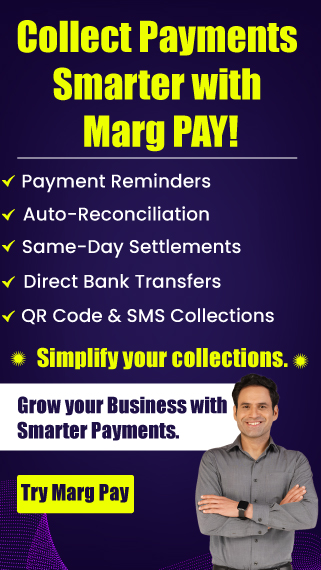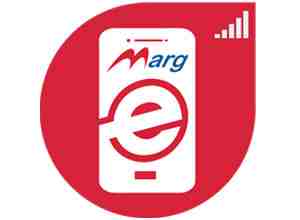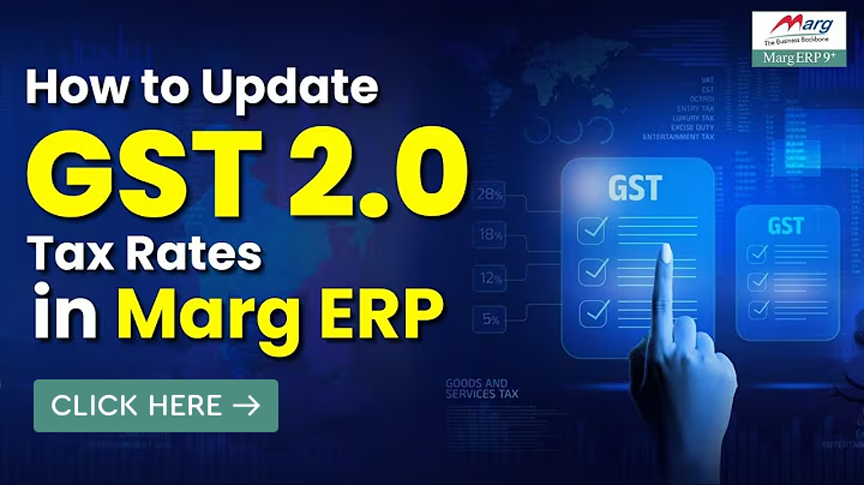Search by Category
- Marg Digital Health
- Marg Nano
- Swiggy & Zomato
- ABHA - Ayushman Bharat
- Marg Cloud
-
Masters
- Ledger Master
- Account Groups
- Inventory Master
- Rate and Discount Master
- Refresh Balances
- Cost Centre Master
- Opening Balances
- Master Statistics
- General Reminder
- Shortage Report
- Supplier Vs Company
- Temporary Limit
- Shop QRID and eBusiness
- Cloud Backup Setup
- Password and Powers
- Marg Licensing
- Marg Setup
- Target
- Budget
- Credit Limit Management
- Change ERP Edition
- Ease Of Gst Adoption
-
Transactions
- ERP To ERP Order
- Sale
- Purchase
- Sale Return
- Purchase Return
- Brk / Exp Receive
- Scrap Receive
- Brk / Exp Issue
- Scrap Issue
- GST Inward
- GST Outward
- Replacement Issue
- Replacement Receive
- Stock Issue
- Stock Receive
- Price Diff. Sale
- Price Diff. Purchase
- BOM
- Conversion
- Quotation
- Sale Order
- Purchase Order
- Dispatch Management
- ERP Bridger
- Transaction Import
- Download From Server
- Approvals
- Pendings
- Accounts
- Online Banking
-
Books
- Cash and Bank Book
- All Ledgers
- Entry Books
- Debtors Ledgers
- Creditors Ledger
- Purchase Register
- Sale Register
- Duties & Taxes
- Analytical Summaries
- Outstandings
- Collection Reports
- Depreciation
- T-Format Printing
- Multi Printing
- Bank Reconcilation
- Cheque Management
- Claims & Incentives
- Target Analysis
- Cost Centres
- Interest and Collection
- Final Reports
-
Stocks
- Current Stock
- Stock Analysis
- Filtered Stock
- Batch Stock
- Dump Stock
- Hold/Ban Stock
- Stock Valuation
- Minimum Level Stock
- Maximum Level Stock
- Expiry Stock
- Near Expiry Stock
- Stock Life Statement
- Batch Purchase Type
- Departments Reports
- Merge Report
- Stock Ageing Analysis
- Fast and Slow Moving Items
- Crate Reports
- Size Stock
-
Daily Reports
- Daily Working
- Fast SMS/E-Mail Reports
- Stock and Sale Analysis
- Order Calling
- Business on Google Map
- Sale Report
- Purchase Report
- Inventory Reports
- ABC Analysis
- All Accounting Reports
- Purchase Planning
- Dispatch Management Reports
- SQL Query Executor
- Transaction Analysis
- Claim Statement
- Upbhogkta Report
- Mandi Report
- Audit Trail
- Re-Order Management
- Reports
-
Reports Utilities
- Delete Special Deals
- Multi Deletion
- Multi Editing
- Merge Inventory Master
- Merge Accounts Master
- Edit Stock Balance
- Edit Outstanding
- Re-Posting
- Copy
- Batch Updation
- Structure/Junk Verificarion
- Data Import/Export
- Create History
- Voucher Numbering
- Group of Accounts
- Carry Balances
- Misc. Utilities
- Advance Utilities
- Shortcut Keys
- Exit
- Generals
- Backup
- Self Format
- GST Return
- Jewellery
- eBusiness
- Control Room
- Advance Features
- Registration
- Add On Features
- Queries
- Printing
- Networking
- Operators
- Garment
- Hot Keys
-
GST
- E-Invoicing
- Internal Audit
- Search GSTIN/PARTY
- Export Invoice Print
- Tax Clubbing
- Misc. GST Reports
- GST Self-Designed Reports
- GST Return Video
- GSTR Settings
- Auditors Details
- Update GST Patch
- Misc. GST Returns
- GST Register & Return
- GST RCM Statement
- GST Advance Statement
- GST Payment Statement
- Tax Registers and Summaries
- TDS/TCS Reports
- Form Iss./Receivable
- Mandi
- My QR Code
- E-Way Bill
- Marg pay
- Saloon Setup
- Restaurant
- Pharmanxt free Drugs
- Manufacturing
- Password and Power
- Digital Entry
Home > Margerp > Collaborative Commerce > What is the process of Collaborative Commerce on the basis of E-business Code in Marg Software ?
What is the process of Collaborative Commerce on the basis of E-business Code in Marg Software ?
Overview/Introduction to Collaborative Commerce in Marg ERP Software
Process of Collaborative Commerce on E.Code Basis in Supplier’s Software
Process of Collaborative Commerce on E.Code Basis in Retailer’s Software
OVERVIEW/INTRODUCTION TO COLLABORATIVE COMMERCE IN MARG ERP SOFTWARE
- It is a two way communication through which both the supplier and the retailer can carry out the transactions via business talk on GST number basis/one.
- When a bill is generated, the time taken by the supplier (to create a Sale bill) & retailer (to convert the bill into purchase bill) is same. But the question arises is that when the supplier generates a sale bill then why there is a need for a retailer to put more efforts.
- So, in order to save time and efforts, Marg ERP has developed an option “Collaborative Commerce”. With the help of this option, the invoices get imported automatically for the sale bill generated by the supplier through GSTIN, Mobile No., email address, E-business Code. This can be done in 4 ways i.e. on GSTIN Number & on E Code basis, on Mobile No. basis, on email Address basis.
- The Retailer and the Supplier should be Marg users and are registered with their respective GSTN no.
- The supplier generates a Sale bill for the retailer with the Bill no entered in it. This bill is further uploaded through the internet and is automatically received in the Marg Software of the retailer as Purchase bill in which the same Bill no is entered automatically.
PROCESS OF COLLABORATIVE COMMERCE ON E.CODE BASIS IN SUPPLIER’S SOFTWARE
Additional Tip 1 : Before using the option of collaborative commerce both Supplier & Retailer needs to set base on which the collaborative commerce needs to be done i.e. on E.Code,GSTN bases, Mobile No, Email etc.
Additional Tip 2 : Also, both the Supplier and Retailer needs to make sure that they are Active for Online Purchase in each other's software.
Collaborative commerce on the basis of E.code is worked on the basis of three criteria either both the supplier and retailer don't have GSTIN so they can do collaborative commerce on the basis of E.code, or one of them has GSTIN and other has E.code so they can also do collaborative commerce between them.
Therefore the three basis are as follows:
a. E.Code to E.Code
b. GSTIN to E-code
c. E.Code to GSTIN
Suppose, in our case the Supplier (Marg ERP Ltd) has E.code and Retailer (JBL Pharma) is registered and has GSTIN
- In the software of the supplier, the name of his company is “JBL Pharma” and the GSTIN No. of the supplier is say for e.g. 07AACPA1072C1ZL.
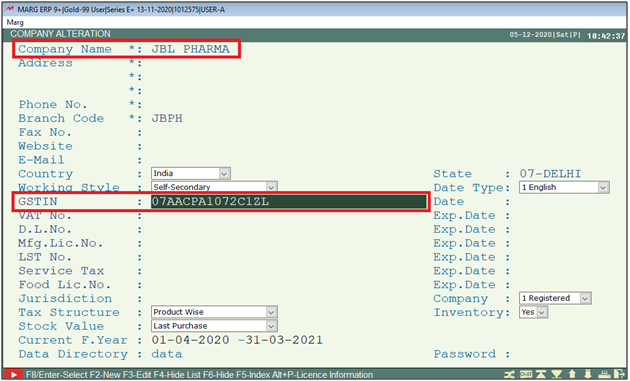
- Let’s generate a Sale Bill. In order to create a Sale Bill, Go to Transactions >> Sale >> Bill. Press Enter.
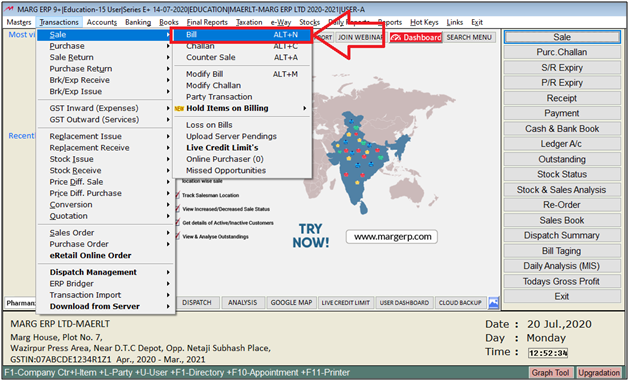
- In order to view the details of the ledger, press F3 Function key. Then enter on Ledger Detail.
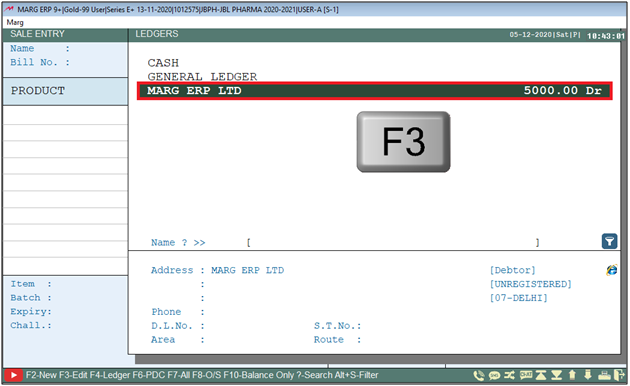
- Then select 'Ledger Details'.
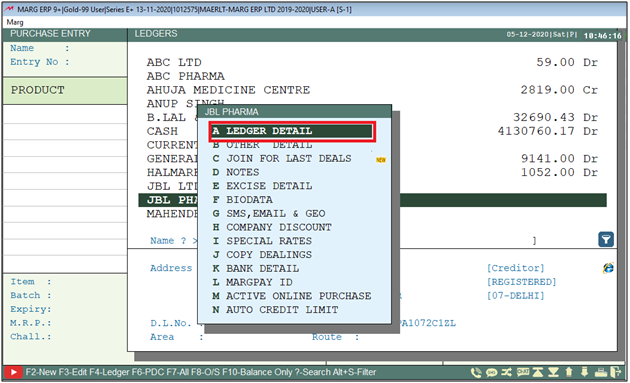
- Then a Modify Ledger window will appear.
Note 1: The Supplier needs to make sure that he has selected the 'E.Code' in 'Bill Export field' in the retailer's Ledger.
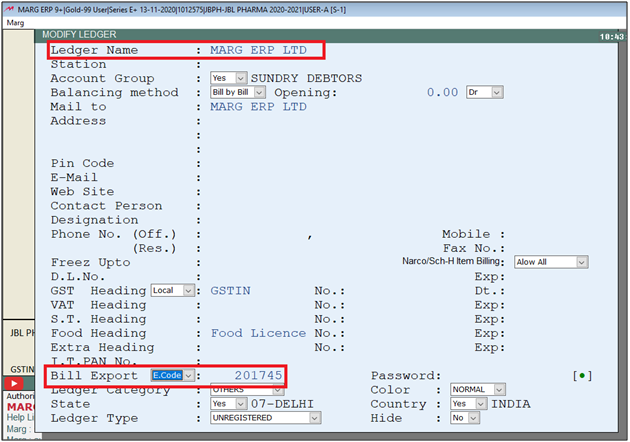
- Suppose, load 1 items into bill and then save the bill by press CTRL+W key.
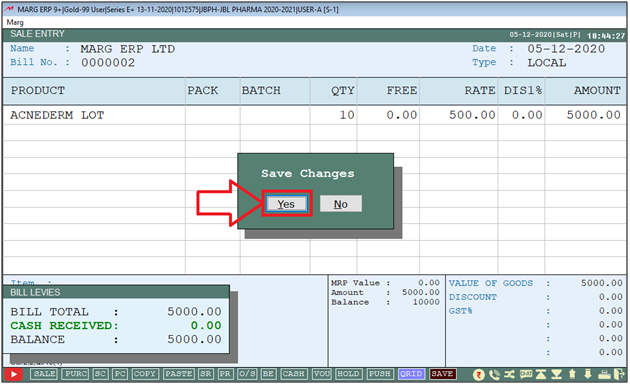
- After saving the bill, go on Transactions > Sale > Upload on Server Pending in order to upload the invoices to the server.
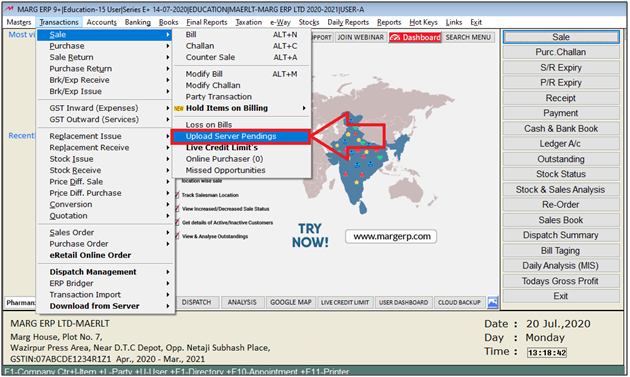
- When the user will enter on Upload on Server, a window will appear of the entire Sale bills which have been generated for the Registered Customers.
- Now Select the bill which needs to be uploaded on the server.
Note 2: A Single bill can be selected by space bar key and multiple bills can be selected by Asterisk key (*).
- Thereafter press F6 key to upload the invoice on the server.
- Then click on 'Yes' to confirm the uploads.
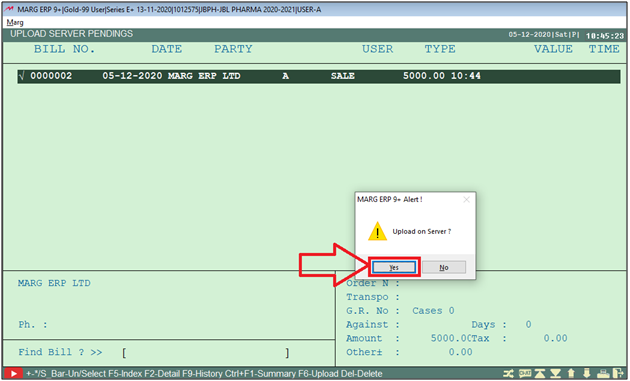
PROCESS OF COLLABORATIVE COMMERCE ON E.CODE BASIS IN RETAILER’S SOFTWARE
- In order to Import Bill no: 0000002, go to Transactions > Purchase > Bill.Press Enter.
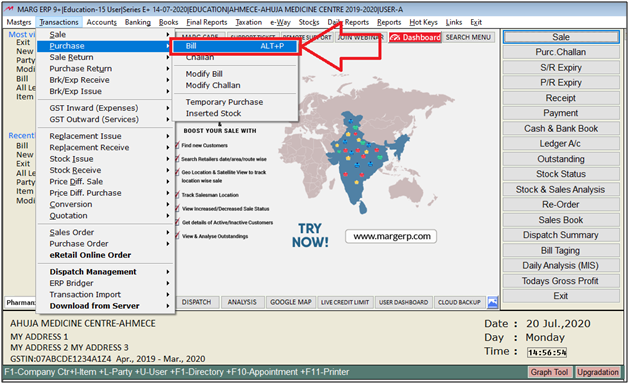
- Then select the Ledger of the supplier and press F3 to view the GSTIN of the supplier.
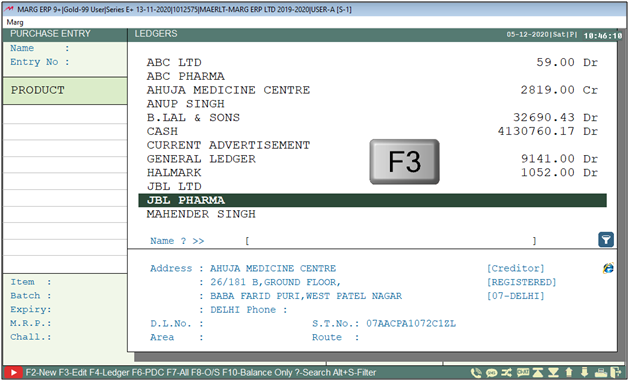
- Here, the user needs to select the 'Ledger Detail'.
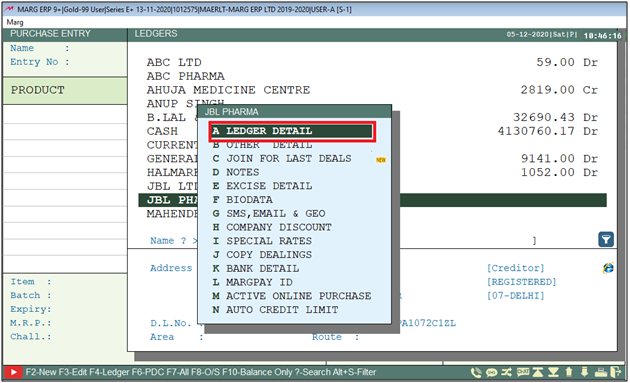
- Here the user can view the GSTIN of the supplier.
Note 3: The Retailer needs to make sure that he has selected the 'GSTIN' in the 'Bill Export field' in Supplier's Ledger.
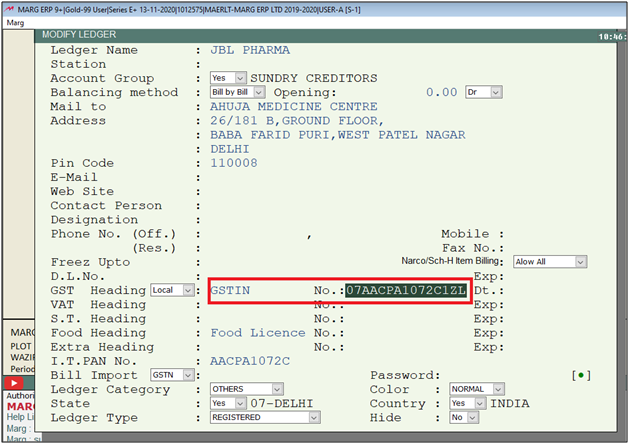
- Once the ledger is selected, the Retailer needs to Press F10 key to import the bill.
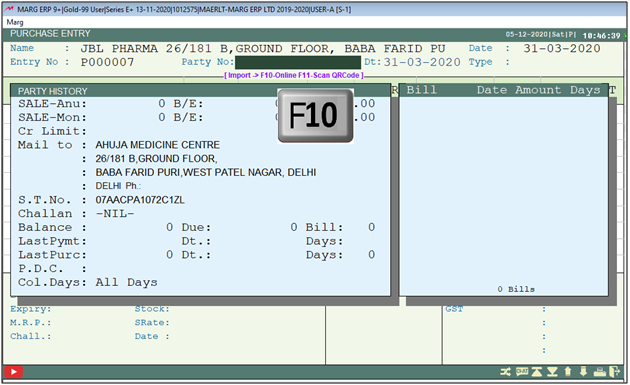
- Now a select bill to import window will appear.
- The user will press Enter on the bill which needs to be imported.
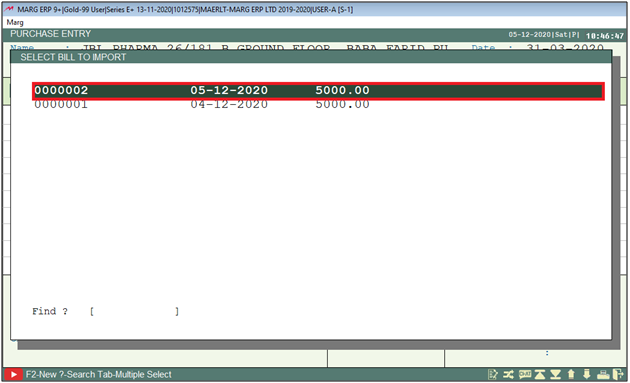
- Then an import Mapping window will appear.
- The user will select the options as per the requirement.
a. In ‘Item Search Base’ the user will select the base for item search from the drop-down.
Suppose, select 'Name'.
b. Now in ‘Show un-matched’ the user will select whether unmatched items will be displayed or all items that are also mapped will be displayed along with the unmatched.
Suppose, select ‘All’.
c. In 'Volume Discount', the user will select whether the user needs to treat the discount as volume discount or to treat as 'Free Qty'.
Suppose, select 'Save in V.Dis'.
d. In 'Replace A-Rate/Replace G-Rate', the user needs to select with which rate the user needs to replace A/G- Rate.
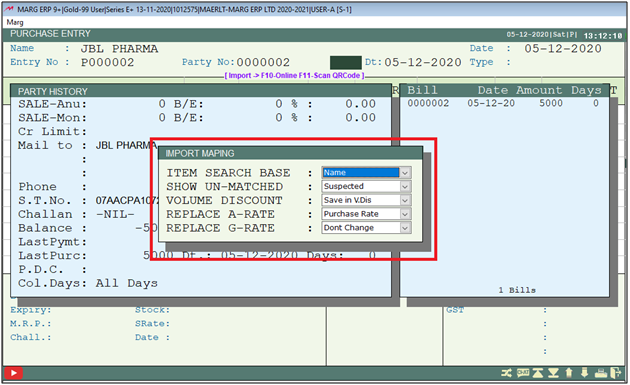
- Then an ‘Item Mapping Total Records’ window will appear.
- Here, all the items of that bill will get displayed which needs to be imported into the software.
a. If an item is not been created in the software then the user needs to create it first by pressing (+) on this window.
b. If the item is already been created in the software then the software will automatically map the existing items or if the user needs to map it with other items then can map by pressing the Enter key on it.
Suppose, in our case the item is already been already created so software is asking to map the item.
- Therefore, press Enter to map the item.
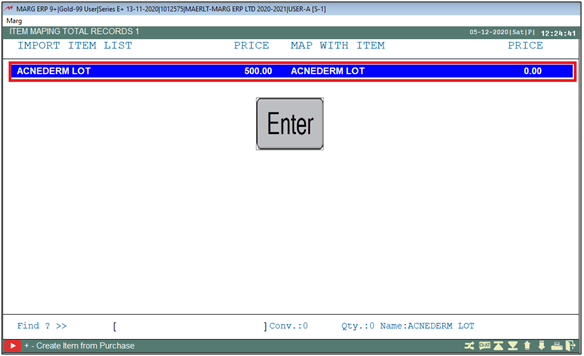
- Now a map item window will appear.
- Select the item and press Enter on it.
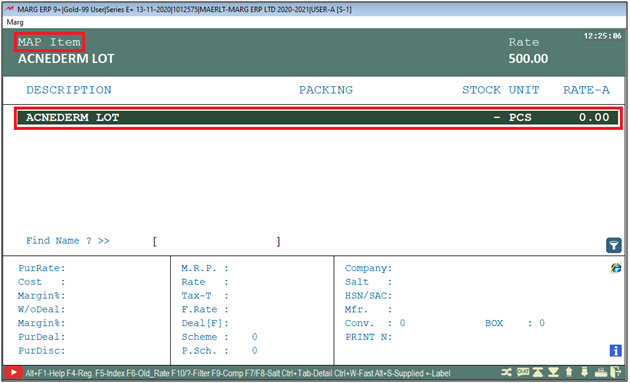
- Now after mapping the item, press ESC key to save the changes.
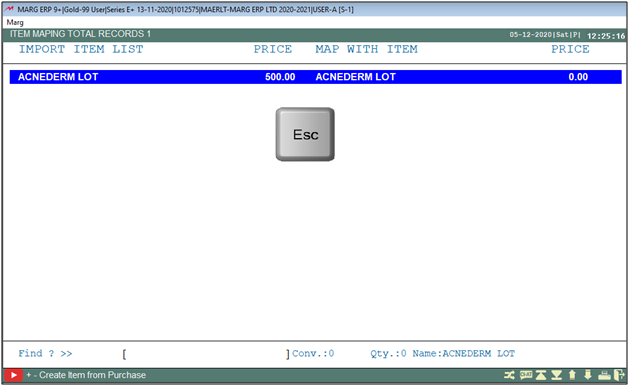
- Thereafter a save changes window will appear in which the user needs to click on 'Yes' to save the details.
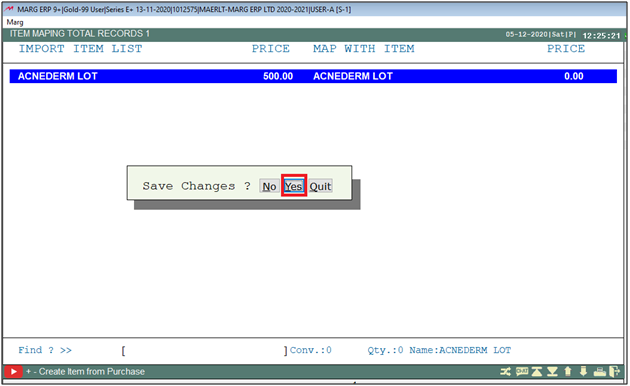
- Now, the software is indicating that all the items have been matched.
- So, Enter “Accept” to continue.
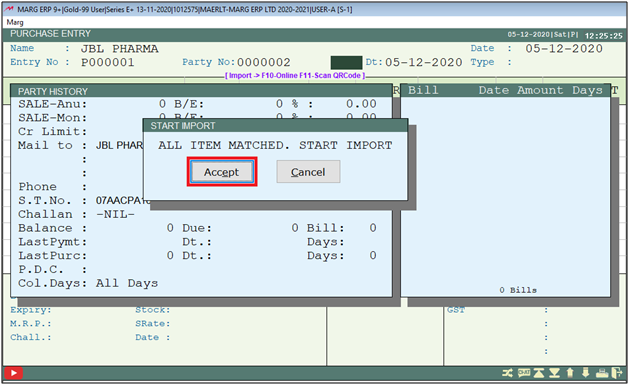
- Thereafter software will show an alert of 'Imported Successfully'.
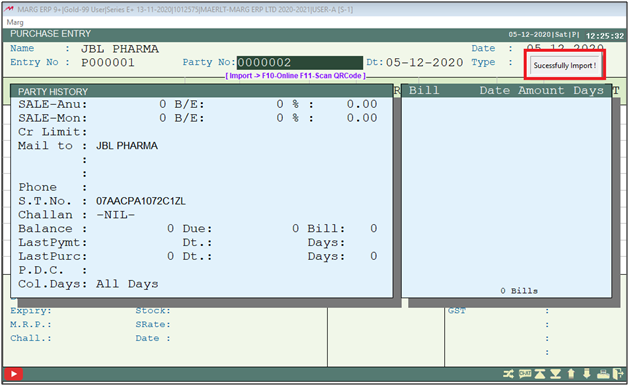
- Once, the process is being completed, the user can view the item that has been loaded into the bill.
- Now save the bill by pressing CTRL+W key.
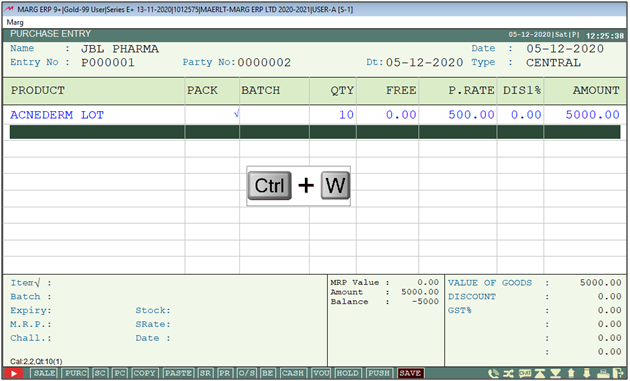
- Now, A Save Changes window will appear.
- The user will select 'Yes' to save the changes.
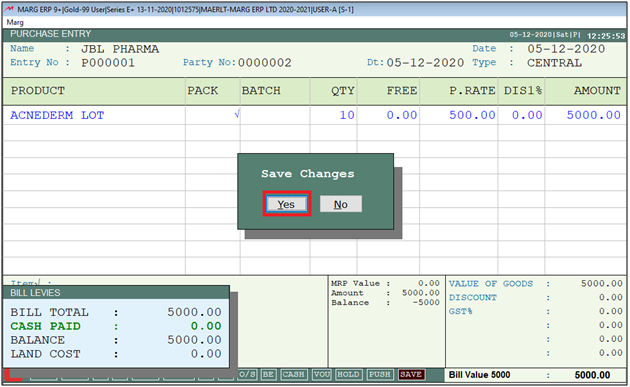


 -
Marg ERP 9+
-
Marg ERP 9+

